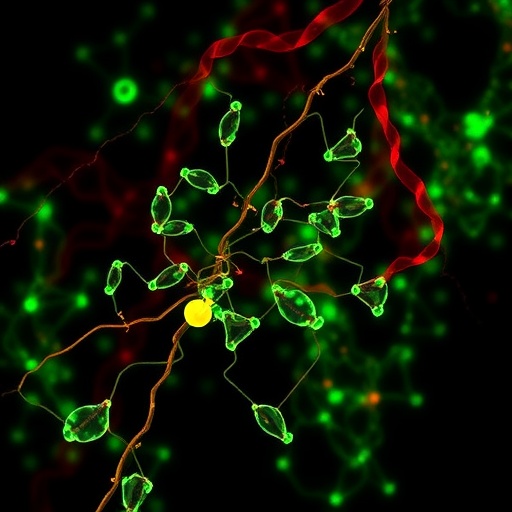Recent advancements in understanding the mechanisms of diseases have unveiled the intricate roles played by exosomes and their contents in various physiological processes, including gestation. A groundbreaking study by Zhang et al. has highlighted a specific exosomal component derived from decidual macrophages, termed circDNAJB6, which appears to significantly influence the progression of preeclampsia, a serious pregnancy-related condition. This research uncovers a complex interplay within cellular signaling pathways that could provide novel insights into managing and potentially mitigating the impact of this condition that affects approximately 5-8% of pregnant women globally.
Preeclampsia is characterized by high blood pressure and signs of damage to other organs, often the kidneys, and presents risks not only to the mother but also to the fetus. The research team led by Zhang sought to unravel the cellular and molecular mechanisms underlying the pathogenesis of this condition, focusing specifically on how exosomes could be manipulating these critical processes. Their findings contribute to a growing body of literature asserting that exosomes are not simply garbage bags for cellular byproducts but rather active participants in intercellular communication.
Exosomes are small extracellular vesicles, ranging from 30 to 150 nanometers in diameter, that are released from many cell types into the extracellular environment. They carry a variety of biomolecules, such as proteins, lipids, and nucleic acids, which can modulate the behavior of recipient cells. The circDNAJB6 identified in this study emerged from decidual macrophages, highlighting a novel source of regulatory molecules that impact pregnancy.
One of the pivotal aspects conveyed in this research involves the miR-670-5p/TOB2 axis, which was found to be significantly modulated by circDNAJB6. MicroRNAs (miRNAs) are small non-coding RNA molecules that play crucial roles in regulating gene expression. In the context of preeclampsia, the interaction between miR-670-5p and TOB2, a known negative regulator of cell growth and survival, suggests a mechanism through which decidual macrophages can influence placental development and maternal vascular adaptations.
Additionally, the activation of the PPARγ/NF-κB signaling pathway emerged as a key mechanism by which circDNAJB6 affects preeclampsia progression. PPARγ, a master regulator of adipogenesis and glucose metabolism, has also been implicated in the regulation of inflammation and immune responses. NF-κB is a transcription factor well-known for its role in mediating inflammatory responses. The interplay between these pathways underscores the complexity of the inflammatory milieu in preeclampsia and provides potential therapeutic targets.
What makes this study particularly significant is its potential implications for therapeutic interventions. By understanding the exosomal cargo and the signalling mechanisms it mediates, researchers may be able to identify novel biomarkers for early detection of preeclampsia, as well as pinpoint new therapeutic targets. For instance, interventions that could modulate the levels or activity of circDNAJB6 or the downstream effects on miR-670-5p and TOB2 may provide avenues to mitigate the severity of preeclampsia during pregnancy.
Zhang and colleagues have successfully illustrated a pathway where exosomal circDNAJB6 facilitates detrimental changes in placental and maternal interactions. The relationship between maternal immune responses and placental health is pivotal in maintaining pregnancy integrity. Understanding how macrophages alter the local environment via exosomes could enable future research aimed at ameliorating preeclampsia risk factors.
There is also a significant need for translational research to bridge the gap between bench and bedside. While the findings of this study are promising, they must be followed by clinical investigations to assess the reliability of circDNAJB6 as a biomarker for preeclampsia. Further, exploring the therapeutic manipulation of exosomal contents presents an exciting frontier in prenatal care.
The exploration of circDNAJB6 not only expands our understanding of exosomal functions in gestation but also reinforces the importance of how cellular communication can affect systemic health outcomes. As researchers delve deeper into the intricacies of maternal-fetal medicine, studies like this highlight the potential for innovative approaches to diagnosis and treatment.
In conclusion, the work by Zhang et al. emphasizes the vital role of exosomal RNA in the context of preeclampsia. With a focus on the mechanisms through which these molecules exert their effects, the study opens new horizons in the understanding of pregnancy complications and their underlying biological processes. As the scientific community continues to explore these dimensions, it becomes increasingly clear that exosomes could serve as crucial hubs of information in the management of pregnancy-related disorders, paving the way for effective interventions that could change the landscape of maternal-fetal health.
This pivotal research not only enhances our biological understanding of how preeclampsia develops but also lays the groundwork for future studies aimed at developing diagnostic and therapeutic strategies. The intricate mechanism involving circDNAJB6, miR-670-5p, and the PPARγ/NF-κB pathway may very well represent a leap forward in the fight against a condition that has historically presented both biological and clinical challenges. The implications of this work are profound, as they guide researchers towards therapeutics that could ensure healthier outcomes for mothers and their children.
In summary, Zhang et al. shed light on the promising role of circDNAJB6, positioning it at the center of a critical dialogue surrounding preeclampsia and its management in clinical settings. As the scientific narrative continues to evolve, the hope remains that such insights will translate into actionable strategies that benefit maternal and fetal health on a global scale.
Subject of Research: Role of exosomal circDNAJB6 in preeclampsia.
Article Title: Exosomal circDNAJB6 derived from decidual macrophages promotes preeclampsia progression via the miR-670-5p/TOB2 axis and by subsequently regulating the PPARγ/NF-κB pathway.
Article References: Zhang, L., Tian, X., Liu, M. et al. Exosomal circDNAJB6 derived from decidual macrophages promotes preeclampsia progression via the miR-670-5p/TOB2 axis and by subsequently regulating the PPARγ/NF-κB pathway. J Transl Med 23, 1154 (2025). https://doi.org/10.1186/s12967-025-07220-9
Image Credits: AI Generated
DOI: 10.1186/s12967-025-07220-9
Keywords: Preeclampsia, Exosomes, circDNAJB6, miR-670-5p, TOB2, PPARγ, NF-κB, Maternal-Fetal Health.




